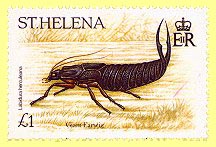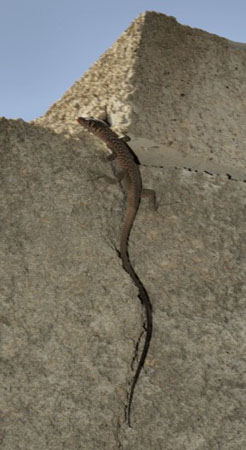|
Under
the Patronage of H.E. Sheikh Nahayan Mubarak Al Nahayan
|
|
The ENHG
Al Ain Chapter
Newsletter
|
|
|
The
Emirates Natural History Group, Al Ain Chapter, PO Box
18057, Al Ain
October, 2005– Issue #229 |
|
THE
IBRAHIM ZAKHOUR TRIPLE CRESCENT TRILOGY:
EPISODE ONE – THE SEARCH FOR
DONKEY SHIT |
Scroll
VI of The Sith Lord,
Robert Fay
photos by Dino Savva |
| A long
time ago (well Thursday 6th October, 2005) in a land
far, far away (well, just over the border in Oman),
an intrepid group of ENHG summit seekers attempted to
scale Jebel Qatar, so named after Jabba the Hutt’s
long lost cousin’s birthplace. Eleven plucky hikers
met at the unspeakably early hour of 06:30 am in the
morning, before noon, hideously early in the day, and
with no chance of a lie-on. With our Grand Master, the
Yoda-like Bill Jones, looking suspiciously more like
Chewbacca than the linguistically challenged green midget,
who is proficient in the ways of the Force, we set off
to conquer Jebel Qatar….
Bill was enthusiastically determined to
use his skill in the ways of the Force to point out
the various local wildlife to our party, but he didn’t
reckon on the curse of the Irish jinx, the ginger haired
Sith lord, Robert Fay, whose presence on any outdoor
excursion will categorically thwart any budding David
Bellamy or Richard Attenborough. And sure enough, despite
Bill’s delusional optimism of spotting Arabian
Oryx, mountain leopards, bactarian & dromederian
camels, tawny owls and mountain eagles, the only wildlife
our party actually saw were; 1 gecko which had hitched
a ride from the Buraimi Hotel in Geoff’s car,
1 tiny lizard no bigger than a thumb nail, 1 dead goat
and a few ants. The Sith Lord strikes again. |
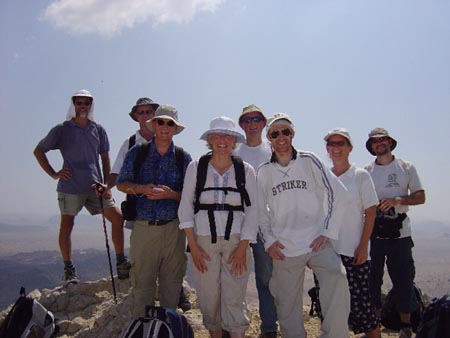 The Sith
Lord with apprentices on Jebel Qatar summit –2005
CE
The Sith
Lord with apprentices on Jebel Qatar summit –2005
CE |
|
‘But
the mountain still had to be climbed and thanks
to Bill’s spooky eidetic knowledge of the
labyri-nthine ways up to the top, we were treated
to an ever changing kaleidoscope of terrain mosaic.
We got a taste of a water eroded wadi, treacherous
scree, shady overhangs, and a descent down the
narrow, claustrophobic “Chimney”,
which shaved an hour off our return leg. And the
view from the top was tremendous – an agora-phobic’s
dream.
Some of our party won-dered how Bill could pick
his way through such |
|
|
|
| This broadsheet is published free to families in
the Al Ain area. If you are a member planning an activity with a natural
history theme please notify us so that others can join you. Everybody
is able to contribute to ENHG and Emirates recordings. For more on
our activities please visit our website <www.enhg.org> or join
our e-mail discussion group at ENHG@Yahoogroups.com. The Group meets
at 7.30pm on the 2nd & 4th Tuesday of the month, usually at the
Intercontinental Hotel. New Members are welcome. |
|
---------------------------------------------------------------------------------------------------------------------------------
| The ENHG
Al Ain Chapter Newsletter…
October, 2005– Issue #229
|
THE SEARCH
FOR DONKEY SHIT cont… |
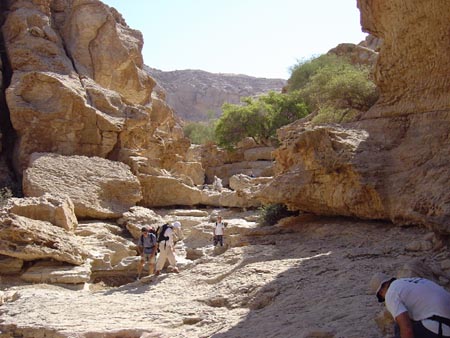
“Look out for the donkey
shit and ignore the goat shit” |
|
| similar terrain and paths
so effort-lessly, without the aid of a high tech GPS satellite
transponder, or a cartographical contour contrast (CCC),
i.e., a map to you and me; and repeatedly asked our wadi
guru how he managed this naviga-tional feat. His mantra
like answer never varied: “Look out for the donkey
shit and ignore the goat shit”. At first, we thought
that this was a touching concern for the state of our
footwear. However, further questioning revealed that Bill
relied on the scatological output of feral donkeys as
his own version of Ariadane’s thread. |
|
| Apparently, these feral herds
of asses (did the 11 humans climbing a mountain in 30+
degrees of heat constitute another herd?) are unerring
in finding their way up and down the mountain, and the
excrement of the more navigationally challenged goats
is to be avoided like red herring. Indeed, the desiccated
carcass of the dead goat mentioned earlier as one of the
wildlife highlights is testament to the folly of following
goat shit!!
And so it was that 11 humans could be seen climbing
Jebel Qatar on Thursday morning, eyes down and olfactory
senses heightened in the elusive search for fresh donkey
droppings. And of course, needless to say, we never
actually saw any live feral donkeys, despite Bill’s
assurances that only two weeks prior, he’d seen
the largest feral herd ever. In the end we were left
wondering, if, like Hansel, Bill wasn’t surreptitiously
discarding donkey turds along the path to create the
illusion of wildlife, and to make asses out of the humans
searching for the contents of asses’ asses. However,
more careful analysis of Bill’s mantra reveals
a worrying case – isn’t is scary that with
the exception of David Bellamy, anyone could tell the
difference between donkey shit and goat shit?? |
|
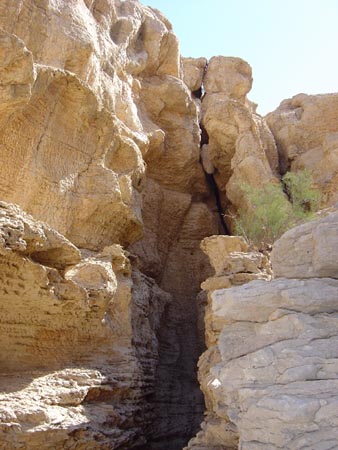 “The Chimney”
“The Chimney” |
|
|
|
--------------------------------------------------------------------------------------------------------------------------
| The ENHG
Al Ain Chapter Newsletter…
October, 2005– Issue #229
|
THE SEARCH
FOR DONKEY SHIT cont… |
| In all, there and back again took
about 8 hours, and was a very enjoyable early October jaunt
up a mountain, being wonderful to escape the hustle and bustle
(well, almost) of Al Ain, to get a dose of fresh air (despite
the donkey shit) and a dash of exercise. Oh, and lest I forget,
not more than ten minutes from reaching the cars, we did indeed
spot two majestic vultures hovering above in the thermals of
the azure sky. I take it all back Bill!!
Thanks to the committee of the ENHG for organizing this climb
and especially to Bill Jones. We’re looking forward
to the next one.
| |
UAE
Weevils Identified at the Natural History Museum, London |
article
by Mike Gillett
photos by B. Reimer |
On the 20th October, I had to visit
the Natural History Museum in London to pick up some historical
museum furniture that we had bought on e-bay. As my son Conrad
has just moved to the Museum to do his MSc in Taxonomy and Biodiversity,
it was an opportunity to meet up with him and with Max Barclay,
the Museum’s beetle curator. I was keen to see some of
the collection holdings of an American group of scarab beetles
- the Phanaeini or rainbow dung beetles - and some of my other
favourites, the ground beetles of the tribe Carabini.
In a way, the scarabs were disappointing as much of the material
was out on loan to Dr. W.D. Edmonds, the American authority
on this group. He is actively revising the interesting necrophagous
genus Coprophanaeus. I should have been forewarned about this
because my own material on this group from NE Brazil is also
about to be sent to him for study. One other beetle that I was
keen to see featured in my last-but-one talk to the Al Ain ENHG.
It is Burchell’s Ground Beetle (Aplothorax burchelli)
from St. Helena thought to be possibly extinct. I had never
seen it and in my talk, I was only able to show its image from
a 1982 postage stamp. Let loose in the collection, I was able
to find a drawer with about 10 specimens. I was surprised to
find that at about 3 cm, it was somewhat bigger than I had anticipated
and despite its overall black colouration, its relationship
to the much more colourful northern hemisphere Carabus and Chilean
Ceroglossus was apparent. Shortly afterwards, I saw another
friend, Howard Mendel, and was amazed to hear that he is shortly
off to St. Helena on the Museum’s behalf. His mission?
To attempt to rediscover Burchell’s Beetle and another
endangered endemic insect, the St. Helena Giant Earwig, Labidura
herculeana, at 8 cm, the world’s largest. I know
that he will have an exciting trip and wish him lots of luck
and success. |
|
|
---------------------------------------------------------------------------------------------------------------------------
| The ENHG
Al Ain Chapter Newsletter…
October, 2005– Issue #229
|
One other thing that I did when
planning my trip to the Museum was to sort out some specimens
of UAE weevils that I had hitherto been unable to identify.
Unfortunately, I was unable to access part of my collection
for specimens, but I did take some 30 odd specimens representing
five different species with me. Weevils are those beetles
that have their head produced into a snout or, more correctly,
rostrum. They are exclusively phytophagous (vegetarian) and
usually, but not always small in size. The family name is
Curculionidae and it is the largest family of animals in existence,
even though several other families such as Attelabidae and
Brentidae have recently been split from it. There are about
50 species found in the UAE, but they are not well known.
However, one large member of the family is becoming better
known and features quite often even in the UAE press. It is
the Red Palm Weevil, Rhynchophorus ferrugineus, which was
accidentally imported into the UAE and elsewhere in the region
some 20 years ago. This highly damaging pest of date and other
palms has spread from its original home in southern Asia to
the whole of Middle East and North Africa and has even reached
Spain. |
|
Ammocleonus hieroglyphicus
(Olivier)
Hypolixus rubicundrus South
Hypolixus nubilosus Boheman
Neocleonus sannio Herbst |
|
|
|
The large number of weevil
species makes their identification that much harder
than for other beetles, but luckily weevils, like most
other large groups, are subdivided into subfamilies
and tribes. Before I left for the Museum, I already
knew that four of my UAE weevils belonged to just one
of these tribes, the Cleonini, and the fifth to a related
genus called Lixus. Even with this information, the
task would have been daunting if it had not been for
Max’s help. He certainly knows his weevils and
his advice helped me to make positive identifications
for all four cleonines:
The Museum has numerous specimens of all four taxa and
it was exciting to find several specimens with familiar
collector’s names attached such as that of Harry
St. John B.
|
|
| Philby, the British explorer and arabist. In
the end, time ran out and I was unable to complete the identification
of the Lixus specimen, but this is a difficult genus.
However, I have been encouraged by my small successes and I
plan another visit to NHM before I take up my new job in the
Caribbean in January. Next time, I will return with the Lixus,
another cleonine, Larinus, found on Echinops
globe thistles at A’bul and other weevils including two
black and white species that mimic bird droppings. |
|
|
----------------------------------------------------------------------------------------------------------------------------
| The ENHG
Al Ain Chapter Newsletter…
October, 2005– Issue #229
|
Iftar Dinner
2005 – Hosted
by the Zayed Center for Heritage & History |
article
by Brien Holmes
On behalf of the members, I want to express my thanks to
Barb Reimer who accepted the challenge this year to organize
our annual Iftar Dinner, held for the third year in a row
at the Zayed Center for Heritage and History. Close to 70
were on hand for the meal provided by the Al Ain Intercontinental
Resort . . . the hotel staff under the excellent supervision
of our good friend Pinto. That the evening went as smoothly
as it did was evidence of the superb manner Barb organized
the event for us. Thanks.
I also wish to thank Dr. Hassan Al Naboodah for all of his
help and for his sincere enthusiasm! When I went to see him
about the event in September, he had already booked the date
and was looking forward to hosting the ENHG members! A special
word of thanks for the traditional (local) sweets he provided
as well as his generous gift of copies of the recently completed
book containing all of the presentations made at the first
Al Ain archaeology conference!
Last, but certainly not least, a sincere thank you to Dr.
Abdullah Khuwaileh who stepped in on very short notice to
be our guest speaker. His personal and often humorous remarks
were very much appreciated.
|
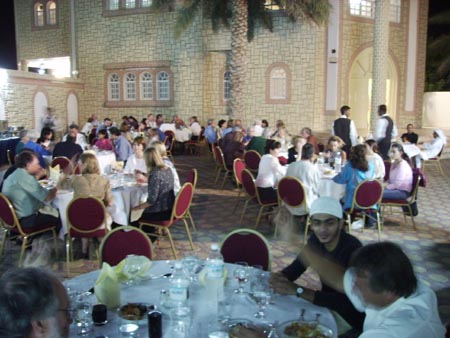 The Zayed Center for Heritage and History
hosted the fifth annual ENHG Iftar dinner
Photo by Steve Ehrenberg
The Zayed Center for Heritage and History
hosted the fifth annual ENHG Iftar dinner
Photo by Steve Ehrenberg
|
| MURPHY TURNER - REMEMBERED |
by Bob Reimer
|
| At the November meeting of the ENHG committee,
it was decided to forward funds donated at the memorial service
and by others in memory of Murphy to the Afghanistan Girls'
School Project run by Solace International (http://www.solaceinternational.org),
one of the ideas suggested by Becky. I have written to the director
suggesting that if there was going to be a Murphy Turner Memorial
in the internet center being built in one of the schools, these
funds be used for that project. Otherwise, the amount funded
a classroom supply kit, a teacher supply kit for one year and
31 student supply kits for one year. If others who did not have
an opportunity to participate wish to donate to the same project,
it is easy to do so online. I used the shipping name "In
Memory of Murphy Turner" to flag the gift appropriately.
The committee also decided to purchase or have built a map
cabinet to house the maps Murphy collected so diligently.
A plaque will be attached to remind people of this generous,
quiet spirit. He will be remembered by those who came to know
him here in Al Ain. Rest assured, we will toast him at the
Christmas-eve-in-the-desert celebration for many years to
come. |
|
|
----------------------------------------------------------------------------------------------------------------------------
| The ENHG
Al Ain Chapter Newsletter…
October, 2005– Issue
#229 |
articles and photos by Bob
Reimer
Jazira – October 7, 2005
Our first October field trip was to a favourite site, Jazira.
This lovely little oasis was an excellent choice since it
is uninhabited and we were likely to have it to ourselves.
The wadi has several aspects to enjoy, especially for the
newcomer. There is a good variety of vegetation in the well-kept
oasis with the date palms, mangoes, bananas and pomegranates.
The abandoned village features a little mosque and a variety
of decaying traditional homes. The graveyard is covered by
aloe vera. I enjoyed stalking the insect life in the oasis
photographing damselflies, bugs, hoverflies and butterflies.
After the oasis visit, the group headed for the pools where
many enjoyed a refreshing swim or wade. A highlight of our
time at the pools was watching the wadi fish fight over Will’s
donated watermelon. A great day to start Ramadan. |

the blue-banded ishnura damselfly |
|
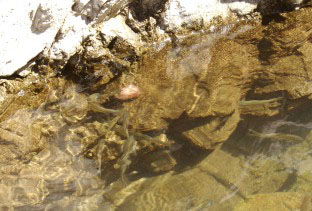 the wadi fish fight over watermelon
the wadi fish fight over watermelon
|
|
Mutaredh Archaeological
Site – October 13, 2005
We were fortunate to have to opportunity to visit a working
archaeological site in Al Ain. Our friends at the Al Ain Museum
invited us to their dig at the Mutaredh oasis near Jahli fort.
The structures at the site likely saw multiple periods of occupation
and appeared to be important buildings from the past century.
Pots, tools and jewelry were found at the site and some were
still in situ. The museum staff gave an interesting interpretation
of what was being found and how the structures had been built.
Thanks to Dia’eddin Tawalbek, Director of Archaeology,
and Ibrahim Al Lababidi, Lab Supervisor of the Al Ain Antiquities
and Tourism Department for this interesting tour. |

the Mutaredh oasis near Jahli fort |
|
 The excavated mosque
The excavated mosque
|
|
|
|
-------------------------------------------------------------------------------------------------------------------------------
| The ENHG
Al Ain Chapter Newsletter…
October, 2005– Issue #229
|
October
Field Trips cont...
|
Sunrise
on Jebel Mahdah and walk at Al Khubayb – October 14,
2005
A surprisingly large group gathered early in the morning at
Buraimi Hotel for the trip up Jebel Mahdah to view the sunrise.
Because of the small parking area at the top, we piled into
three vehicles and headed out. The road to the top the telecommunications
site near the top of Jebel Mahdah is paved, but rains have
eroded deep gullies making some of the ascent challenging.
We arrived on time to settle on the plateau facing east some
450 meters above the wadi plain. As the sun peeked through
the Hajar mountains at about 6:17 AM, shutters snapped furiously
capturing the majestic vista. We had agreed to meet those
who didn’t want to get up so early at the Mahdah fort
at 7:30 AM so we headed down the Jebel at 7:15. Geoff Cosson
led another group that met arrived at the meeting spot perfectly
timed at 7:25 just as we arrived.
From Mahdah, we headed out towards Aboul. Rather then head
into a familiar area, we chose to turn right just before Aboul
and make a rare visit to the wadi just to the south, Al Khubayb.
Al Khubayb appears to have been occupied for quite some time
although it would appear that no one lives there now. The
oasis is still tended though. As we drove in we could see
evidence of stone walls and houses, terraced fields and a
falaj. A small two-story fort commands the entrance to the
oasis area of the wadi. We followed the falaj back to the
wadi then further back to where a deep bowl had been carved
in the rock by two converging streams. On the way back out,
we stopped to take a closer look at the older falaj that had
at one time brought access water from the oasis to the terraced
fields a kilometre about a kilometre away. As some scrambled
up the slope, I spotted a group of tiger beetles by a pool.
Tiger beetles are notoriously hard to photograph because they
are strong fliers and move very quickly. Fortunately I was
able to get some good photos and then one settled into feeding
along the edge of the pool. I was able to get some great shots
but the session was cut short by shouts of “Yallah,
Bob!!” from Brigitte. After the trip, I sent representative
photographs off to our coleopterist, Mike Gillet. He was very
pleased with the photos telling me that I actually had two
species, and that the feeding one was a rare species, Lophyridia
diania, previously only seen at Aboul and otherwise a rare
inland species in Iraq and Iran. I was able to send him coordinates
and pinpoint the location on a map, but didn’t think
this was significant since the site was only a kilometre from
Aboul. Mike responded that “since the known range of
diania in A'bul is basically only from the small dam to about
halfway down to the ford near the entrance gate (i.e. about
100m) the new record is significant. Makes me think that diania
will turn up elsewhere. I remember that it was about 6-7 |

the sun peeked through the Hajar
mountains at about 6:17 AM |
| years before I found elongatosignata [the
other species photographed that is now classified as common]
in Khutwah despite looking for it many times. Might even
be that diania will be found in the UAE sector of the
mountains, especially as this would be nearer to its main
range." |
|
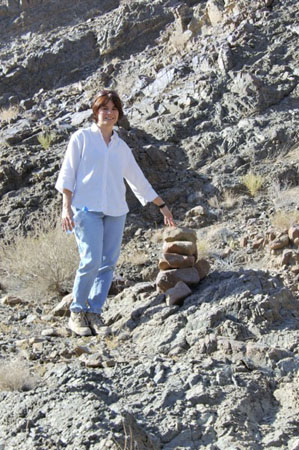 this stack of rocks - a djinn
marker,or
this stack of rocks - a djinn
marker,or
just
a trail marker? |
|
|
|
---------------------------------------------------------------------------------------------------------------------------------
| The ENHG
Al Ain Chapter Newsletter…
October, 2005– Issue
#229 |
October Field Trips
cont...
|
Jabeeb –
October 21, 2005
Jabeeb is a favourite spot for two reasons: introducing newcomers
to camels and interesting archaeology ranging from the recent
past to iron age sites. Since the building of the border fence,
many camel farms were moved from Oman to Jabeeb leading to
one of the largest concentrations of racing camels in the
UAE. The first stop was to see the camels which were, as usual,
present in abundance. The next stop was the gatch pit to see
the remains of wells and hearths. A number of large chunks
of pottery were found that were evidently from very large
vessels, perhaps as much as 1 metre high by 1 metre in diameter.
We then moved on to a site that often yields pottery and remains
of copper pots. Brien and Brigitte used the opportunity to
demonstrate the copper testing kit. The site yielded a mass
of decayed copper which was collected, then Brien crushed
it with a mortar and pestle then put the crushed material
in a glass bottle. Brigitte first added hydrochloric acid
(HCl) to the bottle. If copper is present in the material,
the hydrochloric acid will react with the copper to form copper
salts (CuCl2). She then added ammonia (NH4OH) which, if copper
is present, will form a blue precipitate of cupric hydroxide.
The appropriate smoky reaction occurred and the liquid turned
blue demonstrating the presence of copper. (For more information
see http://home.att.net/~cat6a/metals-XIV.htm. Some interesting
information on detecting copper deposits from orbit can be
seen at http://earthobservatory.nasa.gov/Study/ASTERProspecting/).
A number of members also had fun at the site chasing a toad-headed
agamid (Phrynocephalus arabicus) trying to get pictures
of it.
|
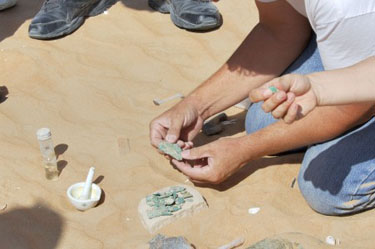
Collect samples |
|
| The move off the graded
track to the sand proved problematic with the large number
of vehicles on the trip. The last couple of cars had to
be extracted. Those that made it through looked around
a recent site with a lot of scattered material. This week
the site yielded a typical haul of pieces of glass bracelet,
spent ammunition, some small coins and a lovely bead |
|
 Crush sample
Crush sample
|
|
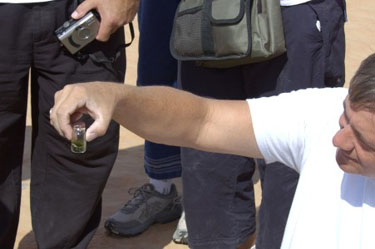
test crushed sample |
|
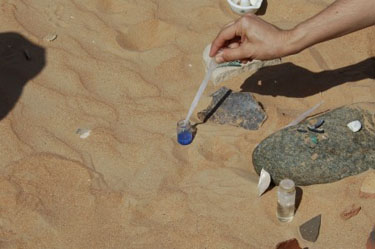 Add hydrochloric acid then ammonia to check for
Add hydrochloric acid then ammonia to check for
typical
copper reaction.
|
|
|
|
--------------------------------------------------------------------------------------------------------------------------------
| The ENHG
Al Ain Chapter Newsletter…
October, 2005–
Issue #229 |
October Field Trips
cont...
|
Subaitah
– October 28, 2005
Subaitah is one of Jerry Buzzell’s favourite oases,
so during the week a number of trip planners got the note:
“Enough fooling around. It’s time to go to Subaitah.
I’ll lead!” Subaitah is a well-tended oasis with
a challenging falaj walk and some interesting archaeology.
Lemons in the oasis were in fruit, but the rush of irrigation
water that is often noted in the spring was absent as many
of the plants are resting for next year. Oman lizards (Lacerta
jayakari) were seen on the way into the oasis on the outside
of a house and on the way out next to a field wall. I was
seduced by the dragonflies around the cistern on the way out
and then the bee flies that were darting about near where
the falaj enters the oasis, so that by the time I got out
to near the end of the falaj, the group was returning. Many
people commented on the frequent presence of masses of snail
shells next to the falaj. These are freshwater snails. They
are special interest of Gary Feulner of the Dubai NHG, so
samples were sent back for him with some guests who joined
us from the Dubai group. |
|
|
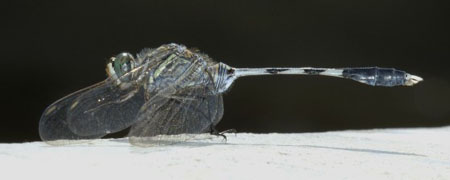
A number of Oasis Skimmer dragonflies
(Orthetrum Sabina) (shown) and Carmine Darters (Crocothemis
erythraea) faired around the settling pond. Both species
tolerate poor water quality. Does that say something about
the quality of water at Subaitah? (Giles, 1998, Tribulus
8.2) |
| This Oman
Lizard played hide and seek on a courtyard wall
on one of the buildings. (Jongbloed, 2000, Wild
About Reptiles, p. 59) |
|
|
|
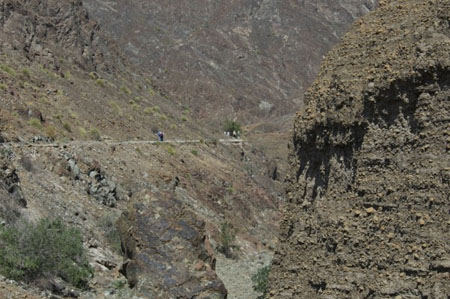
The falaj at Subaitah is built
into a steep slope. In a number of spots, the mountain
wall overhangs the falaj requiring great care to navigate. |
| While
most snail shells appeared to be white, these still
retained some colour. Or are they a different species?
|
|
|
|
|
--------------------------------------------------------------------------------------------------------------------------------
| The ENHG
Al Ain Chapter Newsletter…
October, 2005– Issue #229
|
October Field Trips
cont...
|
article
and photos by Robin Henry
Subaitah – another perspective
A group of 30 keen explorers turned up for our most recent
walk into Subaitah. We were pleased to have with us a couple
from the Dubai Branch of ENHG who had driven down for the
day. For those who haven't been there, Subaitah is at the
end of a smaller version of the Grand Canyon (much smaller),
which has an almost vertical wall on one side and a less acute
wall on the other. A well constructed concrete falaj extends
for what must be nearly a couple of kilometres up the wadi.
All 30 of us walked along the falaj to a water source where
we sat for a while and recouped prior to our return. A couple
of brave souls put their feet into the water, totally disregarding
the likelihood of crocodiles, sharks and other potential hazards.
The rest of us just sat about and relaxed as you can see from
photos one and two.
|
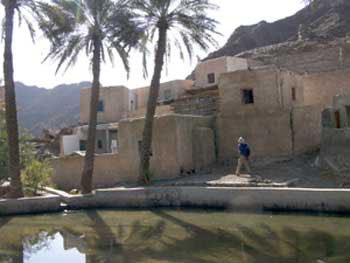
The old village and reservoir |
During our walk we passed
through a small village with an intermediate water tank
and signs of recent inhabita-tion, but no inhabitants
either animal or human. Photo three shows part of the
village. Palms grow there and also several citrus and
fig trees.
The falaj contained numerous creatures throughout its |
|
|
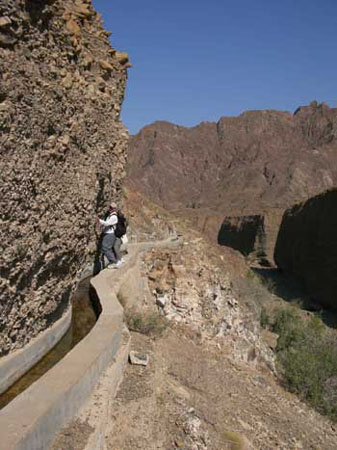 close encounters of the falaj
kind
close encounters of the falaj
kind
|
|
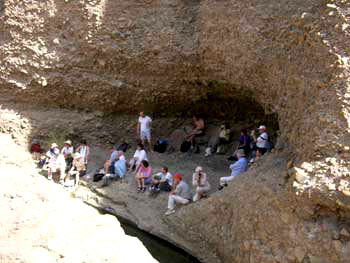
The
group relaxing in the shade by the water |
|
length that many of us
thought looked like common garden variety frogs, but
which, we were told by an apparently authoritative source,
were in fact toads. Not only did we have a great walk
and good company, but we learned that all frogs aren't
frogs!
Several people encountered wasps and one or two very
small lizards were seen scurrying out of the way of
the 30 pairs of feet, some of whose owners needed to
hang on to the hanging wall adjacent to the falaj.
Jerry conducted a short debrief after our walk before
we mounted our vehicles and headed back to Al Ain, another
great adventure under our belts and about which we could
write home."
|
|
|
|
--------------------------------------------------------------------------------------------------------------------------------
| The ENHG
Al Ain Chapter Newsletter…
October, 2005– Issue #229
|
Just by way of a reminder, here are the field trip guidelines
for ENHG outings. We don’t like to insist, at the last
minute that someone ‘should not accompany the group”
because we don’t think they are wearing appropriate
clothing – this is a volunteer group – so please,
volunteer to read the following – and then, if in doubt,
don’t wear it – cover up and protect your skin
from the sun! – Wear solid shoes or boots – not
flip flops or sandals.
A. Dress Code
o Observe the usual courtesies in a Muslim country.
o Loose garments made from cotton or natural fibres are preferred
for comfort (heat and movement). Long-sleeved shirts and long
pants provide the best sun protection, protect against scrapes
and scratches and are culturally sensitive.
o Shorts should extend below the knee if they must be worn.
o Women wearing shorts or a sleeveless top should bring a
shawl and/or shirt to ‘cover-up’ if necessary.
o It is recommended that you wear a hat, headscarf or other
covering.
o Suitable footwear is particularly important. Backless shoes
do not afford sufficient protection or support. Members have
been stung in the toe by wasps while wearing sandals, so they
are not recommended.
B. Essential Provisions
o Heat exhaustion is always an important consideration. It
is recommended that EACH individual carries two (2) litres
of water for personal consumption.
o It is also prudent to use a sunblock.
o Try to carry your possessions so that you are comfortable
and your hands are free.
o Please do not leave valuables (phone, cash etc) in your
vehicle; regrettably there are break-ins at some villages.
C. General Fitness
o Our objective is to include as many people as possible in
each of our activities.
o Certain medical conditions may mean that you are not able
to participate fully. Some field trips are more strenuous
than others.
o If you have a medical condition, or doubts about your fitness
to participate, it is vital that you advise the trip leader
beforehand. Once we are aware of your condition, you will
be able to participate and we will only intervene if you experience
difficulties.
o Diabetics should bring sugar lumps and asthmatics must bring
their inhalers.
o Whatever the level of your involvement, we try to see that
each field trip is rewarding and interesting for all concerned.
D. Preparation
o Review the convoy driving guidelines if you will be taking
your own vehicle on the trip.
o It is strongly recommended that you check the website and
Internet to gain an insight to the area or subject being visited.
o If you have a question, please contact a Committee member
or send an email to the group members at enhg@yahoogroups.com.
|
| YOU WILL THANK YOURSELF FOR FOLLOWING THESE GUIDELINES
IF YOU EVER HAVE TO HELP SOMEONE ELSE BACK TO THE CARS BECAUSE
THEY SLIPPED OR FELL OR WERE EMBARRASSED BY LOCALS.
PREVENTION IS WORTH TEN TIMES MORE THAN REPAIR!
|
|
|
------------------------------------------------------------------------------------------------------------------------------------------------
| The ENHG
Al Ain Chapter Newsletter…
October, 2005– Issue #229
|
Field
Trip Guidelines cont...
|
The above map shows most of the important ENHG locations in
Al Ain. We meet twice a month at the Intercon Hotel, We have
a Resource room at the Al Ain English Speaking School (AAESS).
We meet at the Buraimi Hotel quite often before going out on
weekends. The al Ain National Museum is a meeting place and
also a great place to visit! We take news of any great new finds
to the curator of the museum, Dr. Walid.
The Recycling Center for paper and metal is at the AAESS (gate
closest to town). |
|
|
-----------------------------------------------------------------------------------------------------------------------------------
| The ENHG
Al Ain Chapter Newsletter…
October,
2005– Issue #229 |
The
ENHG Insect Collection
|
article
& photos by Matthew Elliott
"Participants in the ENHG’s bug
evening are introduced, in the course of their initial visits,
to its magnificent collections of arthropods and insects.
While species such as jewel beetles and death’s head
moths draw the eye through their spectacular appearance, others
delight by their names alone. To most a curious story of behaviour
can be attached or some strange feature explained. Dr Brigitte
Howarth pointed out a smallish picture wing fly whose wings
bear a pattern resembling another, smaller fly and thereby
deceive predators into lunging at the wings rather than at
the creature itself.
After observation with the naked eye, the collection may
be examined in detail either through microscopes or Bob Reimer’s
fine close-up photography. Newcomers, however, do not merely
watch but learn to record, handle and affix specimens. Like
pictures they need to be hung correctly in order to be observed
and studied to their best advantage. And as with antique paintings,
the specimens’ pigments change with the passage of time:
some remain brilliant while others alter or fade. Views differ
about how best to preserve such delicate creatures. Sometimes
one wavers between drastic restoration (gluing fallen heads
or limbs with insect cement) and conserving the remainder.
The bug evenings help to diffuse affection, fascination and
respect for these wonderful beasts as well as expertise in
how to recognize, record, preserve and present them. The young
Luke Howarth, a formidable bug-hunter, usually appears early
on with some new specimen which he has picked up at or on
his way to school while Brien Holmes may be counted upon to
enliven the event with his presence and anecdotes."
|
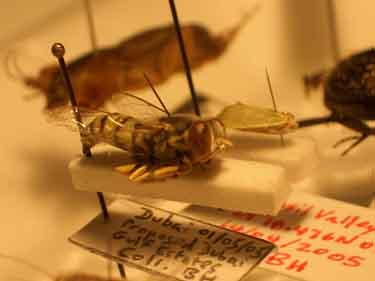
This
mounted wasp is a species of the Genus, Bembix |
|
|
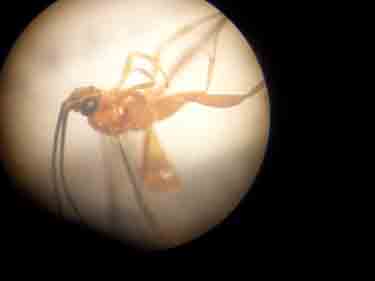 Close-up view through the microscope
of a parasitic wasp.
Close-up view through the microscope
of a parasitic wasp. |
|
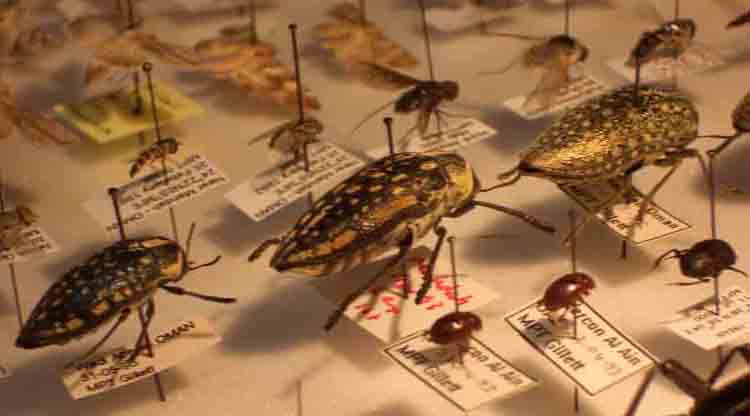 The large beetles are Buprestidae,
or jewel beetles, but the collection includes many families
of insects,
The large beetles are Buprestidae,
or jewel beetles, but the collection includes many families
of insects,
including Diptera, in the row behind the beetles and
Lepidoptera in the back row .
|
|
|
|
|







 “The Chimney”
“The Chimney”
